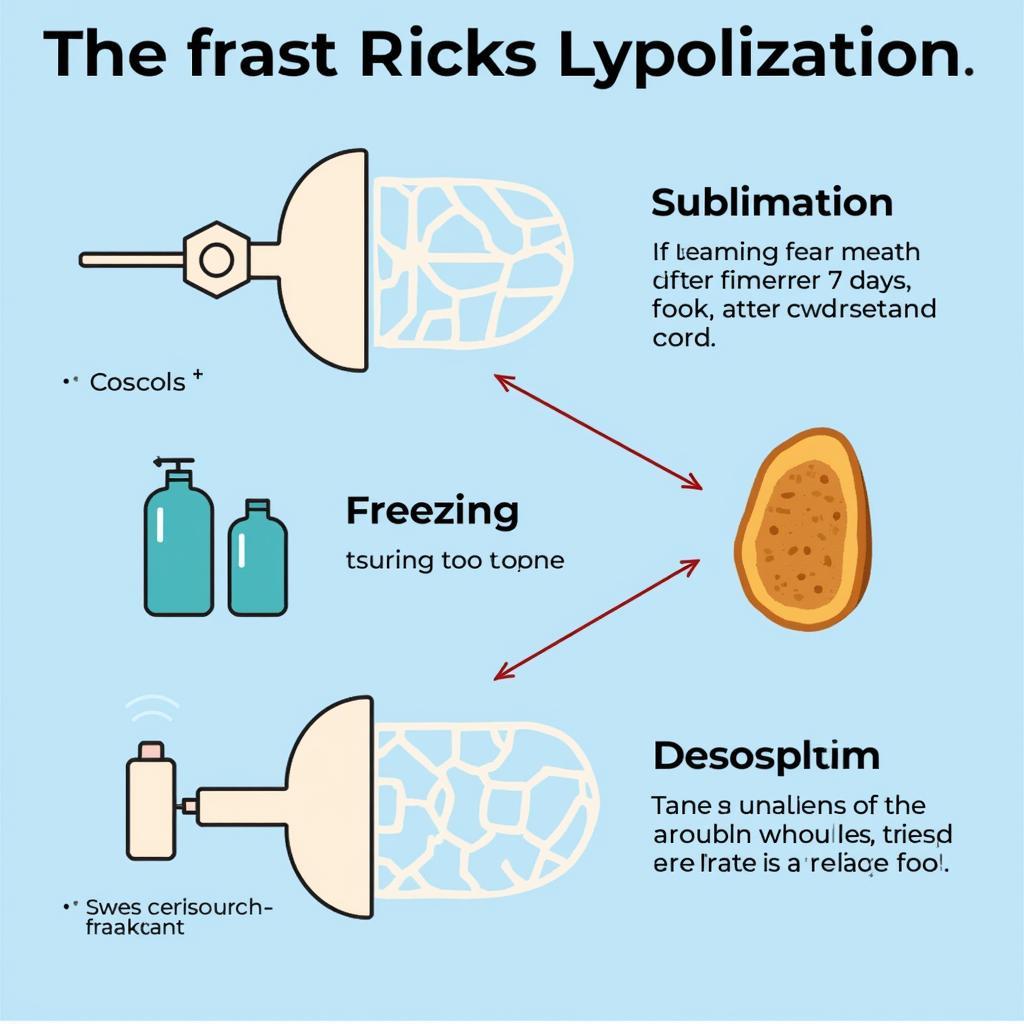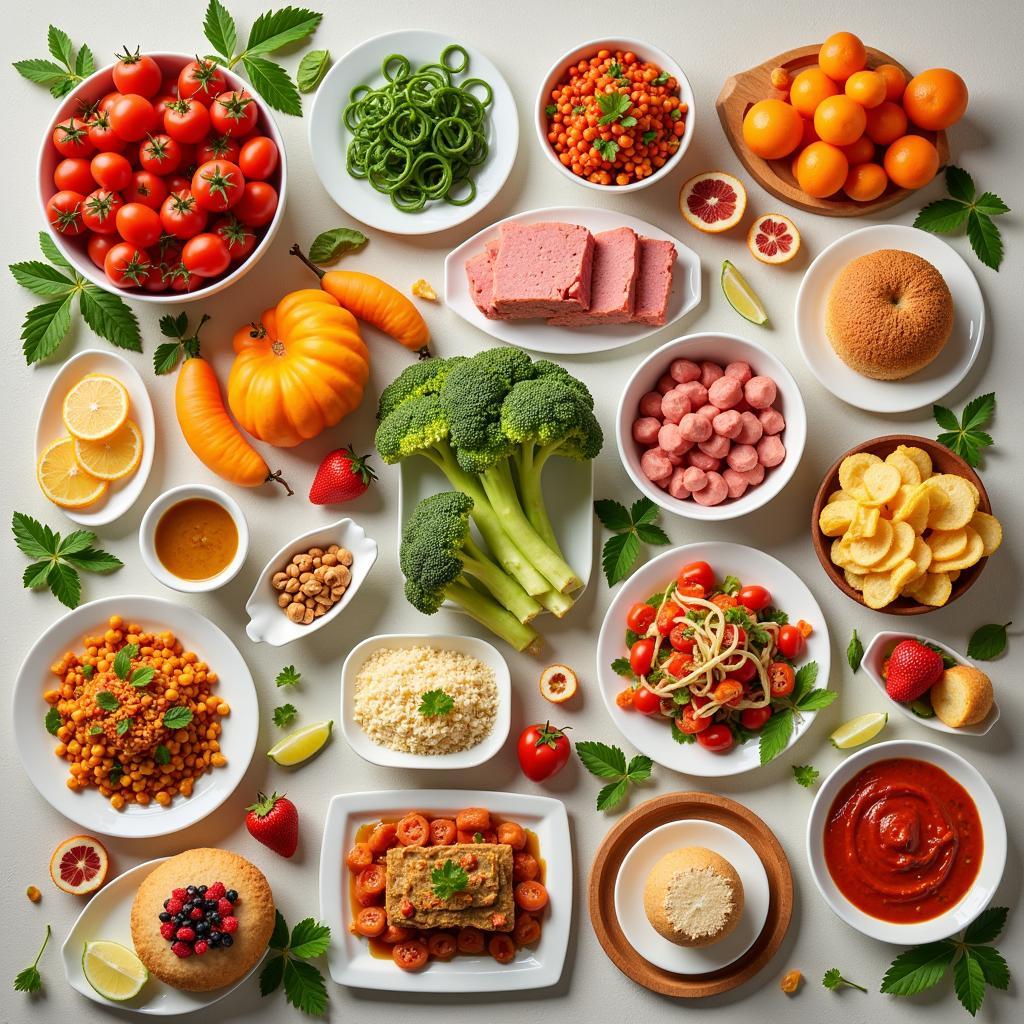Freeze-dried food, or “Lyo Food,” has become increasingly popular in recent years, offering a convenient and shelf-stable alternative to traditional meals. But what exactly is lyo food, and how is it transforming the way we eat? Let’s delve into the fascinating world of lyo food and explore its benefits, drawbacks, and future potential.
What is Lyo Food and How Does it Work?
Lyo food undergoes a process called lyophilization, or freeze-drying, which removes moisture from food while preserving its structure and nutrients. The process involves three main stages:
- Freezing: The food is rapidly frozen, turning the water content into ice.
- Sublimation: Under reduced pressure, the ice transforms directly into vapor, bypassing the liquid phase.
- Desorption: The remaining moisture is removed by applying gentle heat, leaving behind a dry and shelf-stable product.
 Freeze-Drying Process
Freeze-Drying Process
The Benefits of Lyo Food
Lyo food offers a range of advantages over fresh or conventionally preserved food, including:
- Extended Shelf Life: Removing moisture inhibits bacterial growth, resulting in a significantly longer shelf life, often years, without refrigeration. This makes lyo food ideal for emergency preparedness, camping trips, and long-term storage.
- Lightweight and Compact: The freeze-drying process removes up to 98% of the water weight, resulting in compact and lightweight food ideal for backpacking and reducing shipping costs.
- Nutrient Retention: Unlike traditional preservation methods that can degrade nutrients, lyo food retains most of its vitamins, minerals, and antioxidants, making it a nutritionally comparable option to fresh food.
- Flavor and Texture Preservation: Lyo food maintains its original flavor and aroma, and when rehydrated, closely resembles the texture and appearance of fresh food.
 Variety of Lyo Food
Variety of Lyo Food
Lyo Food vs. Dehydrated Food: What’s the Difference?
While both methods remove moisture, lyo food and dehydrated food differ significantly:
- Process: Dehydration uses heat to evaporate moisture, while freeze-drying uses sublimation under reduced pressure.
- Nutrient Retention: Lyo food retains a higher percentage of nutrients compared to dehydrated food, which can lose some nutrients due to heat exposure.
- Texture and Flavor: Lyo food typically rehydrates better, resulting in a texture and flavor closer to the original food compared to dehydrated food.
- Cost: Lyo food is generally more expensive to produce than dehydrated food due to the more complex freeze-drying process.
Is Lyo Food Right for You?
Lyo food offers numerous benefits, but it’s essential to consider individual needs and preferences:
- Budget: Lyo food can be more expensive than traditional groceries, especially for frequent consumption.
- Taste and Texture: While lyo food closely resembles fresh food, subtle differences in texture and flavor might be noticeable for some individuals.
- Preparation Time: While convenient, lyo food requires rehydration, which adds a few minutes to the preparation time compared to ready-to-eat meals.
The Future of Lyo Food
Lyo food is constantly evolving, with advancements in technology and growing consumer demand:
- Innovative Products: From freeze-dried astronaut food to gourmet lyo meals and snacks, the range of products is continuously expanding.
- Sustainable Practices: Lyo food’s long shelf life contributes to reducing food waste, and advancements in sustainable packaging further enhance its eco-friendly profile.
- Global Food Security: Lyo food’s ability to preserve food for extended periods offers a potential solution to global food security challenges by reducing spoilage and distribution limitations.
Conclusion
Lyo food offers a convenient, nutritious, and shelf-stable way to enjoy a variety of foods. As technology advances and consumer demand for high-quality, convenient food options grows, lyo food is poised to play an increasingly significant role in our kitchens and beyond. Whether you’re preparing for an outdoor adventure, seeking nutritious meal solutions, or simply curious about this innovative food preservation method, lyo food offers a world of possibilities.
FAQs about Lyo Food
1. How long does lyo food last?
Properly packaged lyo food can last up to 25-30 years, making it an excellent option for long-term food storage.
2. How do you rehydrate lyo food?
Rehydrating lyo food is simple: add boiling water or broth to the food pouch, stir, seal, and let it sit for 5-10 minutes.
3. Is lyo food healthy?
Yes, lyo food retains most of its nutrients, making it a healthy and comparable option to fresh food.
4. Can you freeze-dry food at home?
Yes, home freeze-dryers are available, allowing you to preserve your favorite foods.
5. What are the best foods to freeze-dry?
Fruits, vegetables, meats, low fodmap chinese food, and complete meals are excellent choices for freeze-drying.
6. Where can I buy lyo food?
You can find lyo food at outdoor retailers, online stores, and some grocery stores.
7. Is lyo food expensive?
Lyo food is generally more expensive than traditional groceries but offers significant convenience and shelf-life advantages.
Still, have questions about lyo food?
Contact our team at Mina Cones Food for expert advice on choosing the best lyo food options for your needs.
Phone: 02437655121
Email: minacones@gmail.com
Address: 3PGH+8R9, ĐT70A, thôn Trung, Bắc Từ Liêm, Hà Nội, Việt Nam
We are available 24/7 to assist you.